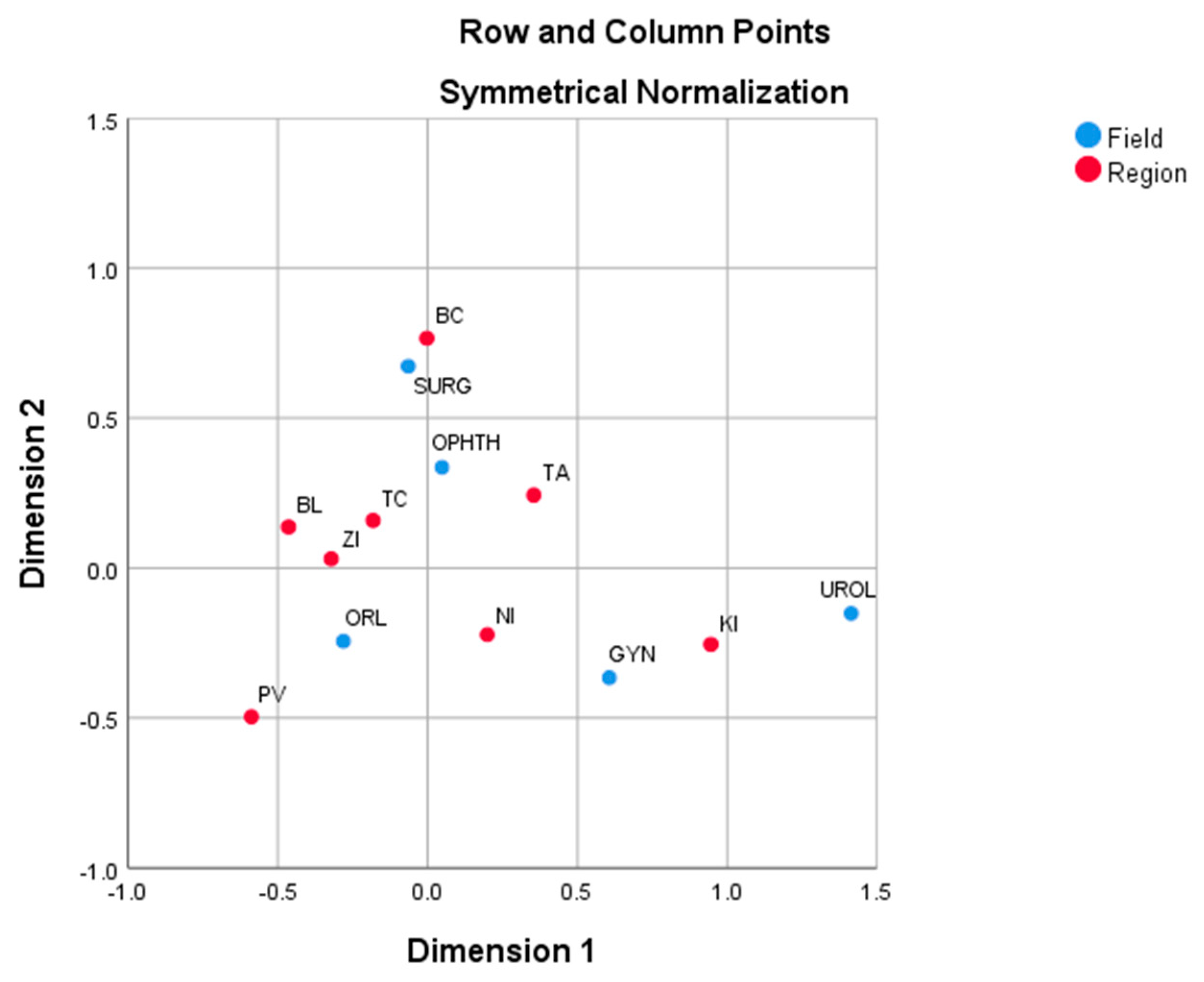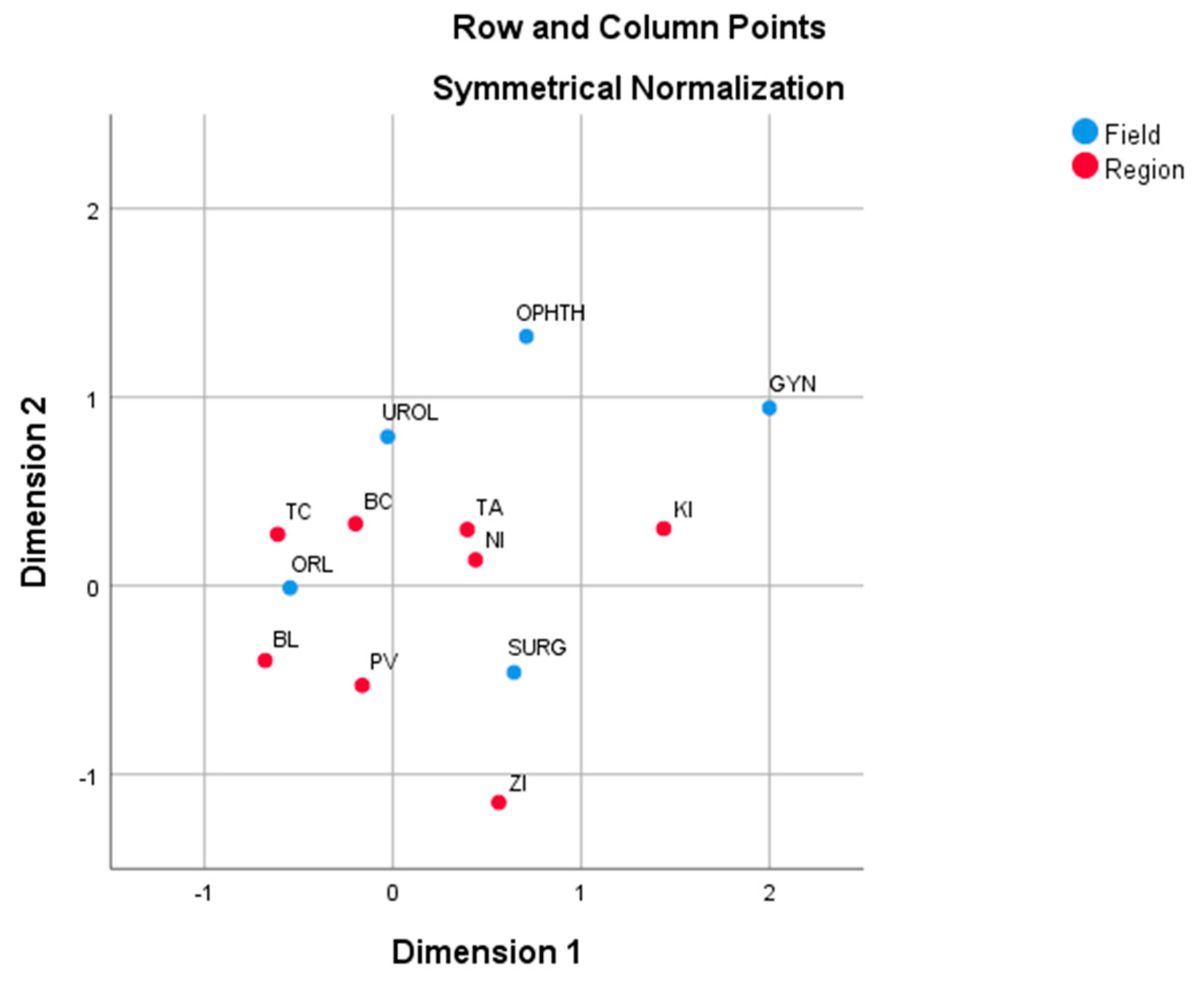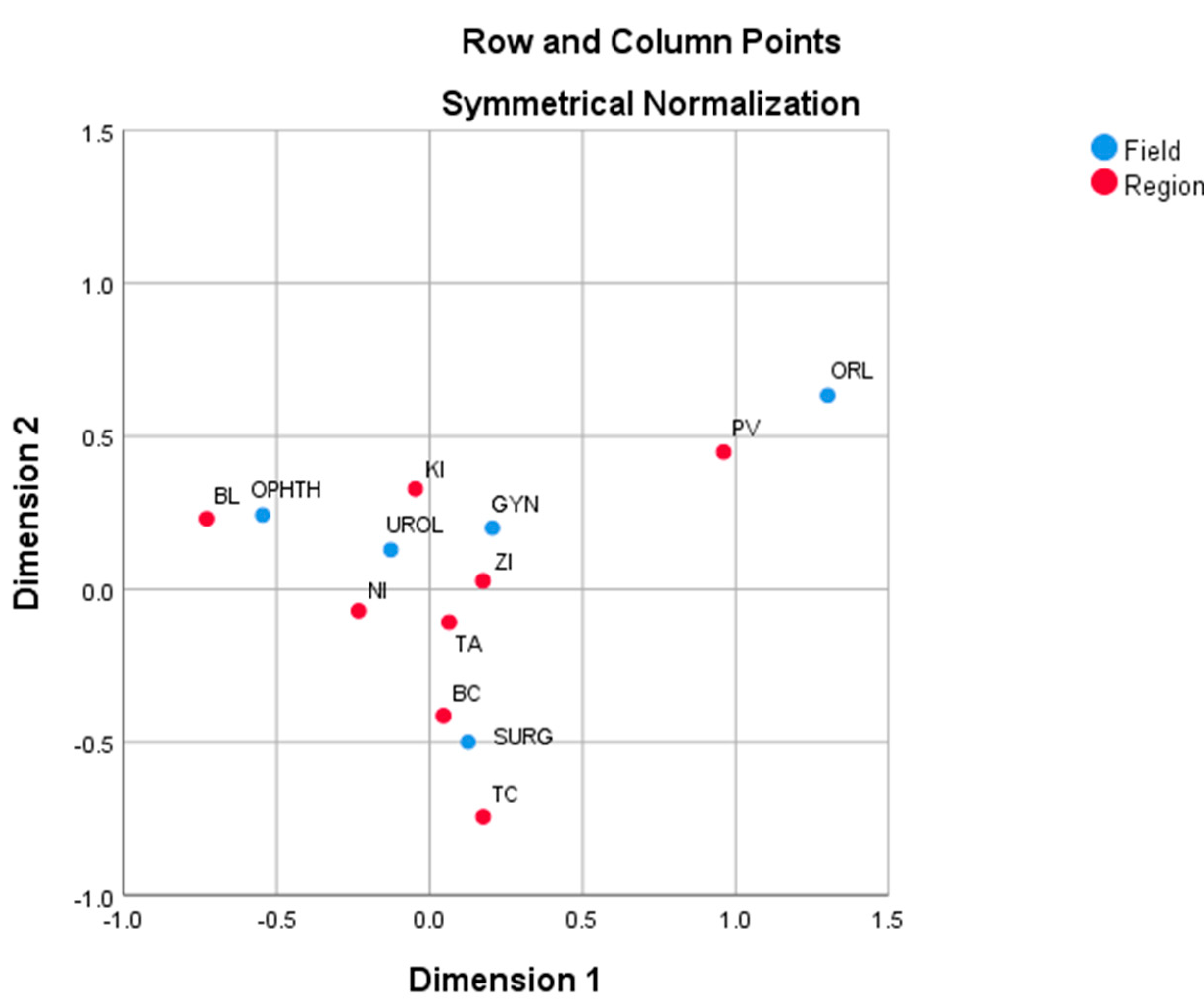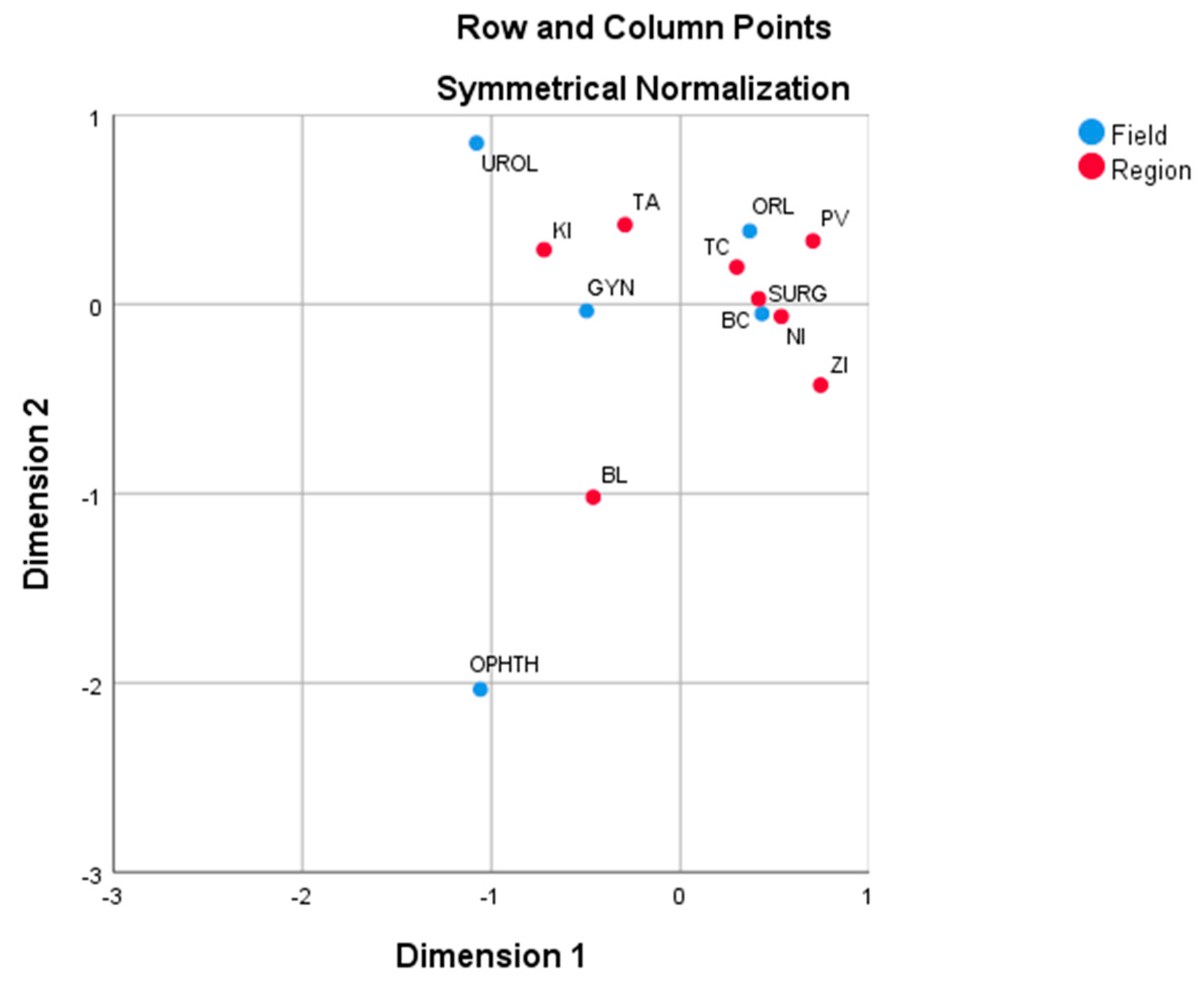Research studies that deal with day surgery belong to two fields of science: Medicine and medical management. Medical studies primarily focus on casuistry, and they provide little information for the economic sphere. Their aim is to improve diagnostic and medical treatment processes, while sharing medical experiences. Medical management studies have a broad research scope. Organization of the day surgery system, technical support, and economic and capacity parameters are their priority. Many studies from this group analyze patient dissatisfaction, as well as factors that influence their risk level [
6,
7,
8,
9]. These studies are significantly heterogenous in their character. However, they provide valuable topics for comparative analyses and research realizations in the individual conditions of the medical facilities. For instance, Anderson et al. [
10] emphasize the importance of choosing patients correctly for a day surgery regime. Supporting mechanisms for the correct selection of patients and for the success of the operation are technical improvements in surgery and the use of surgical guidelines. A well-trained, motivated, multidisciplinary team in healthcare facilities where day surgery is considered is the gold standard. The authors state that the selection of patients for day surgery has to be precise, taking into account health and social factors, surgical constraints and other aspects that are part of the preoperative assessment. The importance of supportive mechanisms and guidelines for overnight surgery is also described in the study by Ng and Mercer-Jones [
11]. In the UK, day surgery is constantly evolving and expanding. Competent institutions support the development of surgical and anaesthetic techniques as well as integrated health care processes, while using day surgery for a wider range of patients and using more complex procedures. The authors emphasize the importance of the right choice of patients and take into account specific factors that could influence the decision to undergo surgery in the mode of day surgery. In 2011, the Association of Anaesthetists of the United Kingdom and Ireland (AAGBI) issued guidelines for safe and effective day surgery, which are of great importance in preoperative and surgical processes. The goal of continuous improvement of the day-to-day surgery processes is to return a patient to normal life as quickly as possible. Leroy et al. [
4] pointed out in their study the variability in the choice of day surgery interventions between Belgian hospitals in the years 2011–2013. The authors used administrative data analyses which were realized by surgical experts. In total, 486 surgical procedures were analyzed. Expert meetings with 95 doctors and anaesthesiologists from 54 hospitals were also used. The variability in the proportion of day surgery interventions between Belgian hospitals was considerable. This was also confirmed in standard performances with so-called high national daily surgical performance such as cataract surgery, laparoscopic cholecystectomy, etc. The study concluded that if Belgium expects a further expansion of daily surgery, factors that cause a high variability in the number of daily surgical interventions between hospitals should be further explored. A feedback system that would provide data on the evolution of the number of overnight surgeries between hospitals and other providers, and a benchmarking process for the monitoring of several quality indicators, such as unplanned re-hospitalizations and re-operations, visit of emergency medical units, etc., are very important. The high variability in the proportions of day surgery performance may be due to the experience and a sub-specialization of the surgical team. Lipp and Hernon [
12] confronted the rate of day-to-day surgery in the UK with the procedures used. Over the past 20 years, the number of day surgeries has increased by more than five times as a result of improved surgical and anaesthetic techniques. Improvements in surgical experience have made it possible to use more complex surgeries with a higher rate of co-morbidity in patients. At the same time, an increasing rate of complications was not reported. The authors emphasize that day surgery should be a preferred option after considering the patient’s condition, planned surgical procedures and anaesthetics. Patients with multiple co-morbidities may be suitable for minor surgical procedures if general anaesthesia may be avoided. The authors also mention the importance of guidelines in establishing new units and the use of new procedures, the importance of the geographical location of units, and the experience in implementing more demanding surgical procedures. Brebbia et al. [
13] analyzed the surgical department in multidisciplinary day surgery in their study. Between 2003 and 2006, the number of day surgeries increased considerably due to an organization of a good quality and a favorable population acceptance. The authors confirmed that the current organization of day surgery may maintain a high standard of health care and a low incidence of complications compared to the results of studies. The results show that day surgery in Italy is not evenly distributed and there are significant differences between regions. The authors see issues with the implementation of deeper analyses regarding the incompatibility of data resulting from the performance of interventions in the state and private health sector. The study highlights the importance of optimal linkages between organizational, management and clinical aspects. Ahmed et al. [
14] deals with the infrastructure for the provision of day surgery. They are developing a building energy simulation model for a separate day surgery center. The detailed energy audit presented provides an insight into the occupancy rate and operation schedules. The issue of optimizing the cost of performing day surgery and finding opportunities for better organization, economic and personnel utilization also comes to the forefront. Gabriel et al. [
15] discuss in more detail the risk factors and causalities associated with surgery and mortality. The results of the study did not confirm any association between perioperative mortality and the time of day at which operations were performed. Attention is also drawn to a determination of mortality rates for daily and emergency operations. The results of the analyses showed that the time of day was not associated with increased risk of mortality during intraoperative and immediate postoperative period in emergency surgery. Gaucher et al. [
2] investigated the problem of stagnation in the development of overnight surgery in France during this period. Ambulatory surgery is restricted by law to “day surgery” in 12 h, and only 17 procedures are referenced for this surgery. According to the authors, the development of overnight surgery in France had progressed by that time (37% of all surgeries compared to 83% in the United States, 79% in the United Kingdom and 70% in Northern Europe). Conventional hospitalization remained the rule after surgery. In January 2010, university general surgery unit was restructured. It evolved from a conventional unit to a predominantly ambulatory unit. Research results show that it is clearly possible to distinguish the need for care of the need for accommodation and significantly reduce postoperative conventional accommodation. The authors call for a solution to the question of extending the legal period of 12 h to 24 h in order to expand the list of referenced procedures that could support the development of overnight surgery in the country. There are very few studies declaring the most appropriate models of the number and structure of medical staff for day surgery [
5,
6,
15,
16,
17,
18,
19,
20]. Experience in performing day surgery in many countries points to the necessity of its own administrative infrastructure in order to ensure coordinated planning and continuity in the performance of day surgery as well as overall optimization. Many foreign studies (e.g., [
17,
21,
22,
23,
24,
25,
26,
27,
28], and others) have declared an effort to continually expand the day surgery system, both the number of patients operated and the application of more extensive and complex procedures (e.g., [
7,
8,
9]) in patients with higher rates of comorbidity. This creates the preconditions for a more in-depth examination of regional disparities in the development of the number of surgeries performed and the factors that cause them. Their knowledge will help to set up regulatory and stabilization mechanisms in the country in order to achieve a higher efficiency of the health system and to ensure a better quality of life for patients.









